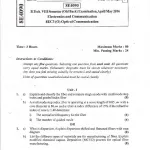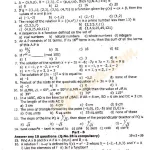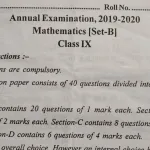Question: What is the significance of Antarctica in understanding Earth’s geological history?
Answer: Antarctica holds half-million-year-old carbon records in its ice layers, providing insights into Earth’s past climate and geological changes.
Question: Why did Geoff Green include high school students in the Students on Ice expedition?
Answer: Geoff Green believed that exposing young minds to the pristine environment of Antarctica would instill a deeper understanding and respect for the planet, shaping future policymakers.
Question: How does the statement “Take care of the small things and the big things will take care of themselves” relate to Antarctica?
Answer: In Antarctica’s simple ecosystem, small organisms like phytoplankton play a crucial role. Protecting them ensures the stability of the entire food chain.
Question: What challenges did Tishani Doshi face during her journey to Antarctica?
Answer: Being from tropical India, Doshi found the cold, barren landscape of Antarctica challenging, both physically and mentally.
Question: Describe the journey undertaken by the author to reach Antarctica.
Answer: The author traveled from Madras, crossing nine time zones, six checkpoints, and three bodies of water, finally boarding the Russian vessel Akademik Shokalskiy to reach Antarctica.
Question: What is the significance of the title “Journey to the End of the Earth”?
Answer: The title reflects the author’s voyage to Antarctica, the southernmost continent, symbolizing a journey to the planet’s extremities.
Question: How does the author describe the landscape of Antarctica?
Answer: She portrays it as a vast, white expanse with no human markers, offering a surreal and pristine environment.
Question: What role do phytoplankton play in Antarctica’s ecosystem?
Answer: Phytoplankton are microscopic organisms that perform photosynthesis, forming the base of the marine food chain in Antarctica.
Question: Why is Antarctica considered the perfect place to study climate change?
Answer: Its untouched environment and preserved ice cores provide clear evidence of historical climate patterns and changes.
Question: How does the author reflect on human impact on the environment?
Answer: She emphasizes that in just 12,000 years, humans have significantly altered the planet, leading to environmental concerns like global warming.
Question: What is Gondwana, and why is it relevant to the chapter?
Answer: Gondwana was a supercontinent that existed millions of years ago, including present-day Antarctica, highlighting Earth’s geological evolution.
Question: How does the author describe the silence in Antarctica?
Answer: She notes a pervasive silence, interrupted only by natural sounds like avalanches or calving ice sheets, emphasizing the continent’s isolation.
Question: What does the author mean by “a chilling prospect”?
Answer: As a sun-loving individual, the author found the idea of spending time in the cold, desolate environment of Antarctica daunting.
Question: How does the journey to Antarctica serve as a metaphor?
Answer: It symbolizes a deeper exploration into Earth’s past and a reflection on the future consequences of human actions.
Question: What lessons does the author hope students take from the expedition?
Answer: She hopes they develop a sense of responsibility towards the environment and understand the importance of sustainable living.
Question: Describe the author’s feelings upon seeing seals sunbathing on ice.
Answer: She felt a mix of awe and concern, pondering whether such serene scenes would persist amid environmental degradation.
Question: How does the chapter highlight the interconnectedness of ecosystems?
Answer: It shows how changes in one part of the world, like Antarctica, can have far-reaching effects on global ecosystems.
Question: What is the author’s view on the role of education in environmental conservation?
Answer: She believes education is crucial in fostering awareness and prompting action to protect the environment.
Question: How does the chapter convey the urgency of addressing climate change?
Answer: By presenting firsthand observations of melting ice and disrupted ecosystems, it underscores the immediate need for action.
Question: What does the author suggest about the future if current environmental trends continue?
Answer: She warns of dire consequences, including the loss of biodiversity and the destabilization of natural systems.
Recommended Indian Reference Books for Journey to the End of the Earth – With Authors and Content Types
1. CBSE Class 12 English Vistas Companion
Author: Renu Anand
Publisher: Full Circle Education
Content: Includes summary, theme-wise explanations, short and long answer questions, and practice worksheets for board exam prep.
2. Understanding Vistas – Class 12 English
Author: Dr. S. Kumar
Publisher: Oswaal Books
Content: Offers in-depth NCERT-based Q&A, value-based questions, and additional HOTS (Higher Order Thinking Skills) questions.
3. English Vistas – Textbook Solutions for CBSE Class 12
Author: Anjana Ghosh
Publisher: Xam Idea
Content: Provides chapter insights, line-by-line analysis, model answers, and grammar practice linked to the chapter.
4. CBSE Chapterwise English Vistas Practice Guide
Author: Meera Kapoor
Publisher: Arihant Publications
Content: Includes previous year questions, assertion-reason format, and exam-oriented exercises for every section of the chapter.
5. Class 12 English Made Simple: Flamingo & Vistas
Author: Kiran Malhotra
Publisher: Educart
Content: Summarized notes, theme analysis, poetic devices (if any), and character impressions from a literary point of view.
6. Exam Ready English Core Class 12
Author: Ravi Prakash
Publisher: Target Publications
Content: Offers sample answers, tips for board presentation, and MCQs for comprehension testing.
7. Insight English Vistas Guide
Author: Dr. Vandana Saxena
Publisher: MTG Learning Media
Content: Focuses on question framing techniques, character sketches, thematic analysis, and vocabulary development.
8. Golden English Guide for Class 12
Author: N. Kumar
Publisher: New Age Publishers
Content: Traditional Q&A format, explanation in both English and Hindi, ideal for bilingual students.
9. Ace CBSE English – Vistas Series
Author: Priyanka Bansal
Publisher: Learnwell Publications
Content: Contains critical appreciation, probable board questions, and visual-based comprehension for modern learners.
10. Saraswati English Core Class 12
Author: Meenakshi Tandon
Publisher: Saraswati House Pvt. Ltd.
Content: Combines textbook solutions with self-assessment exercises and teacher tips for writing high-scoring answers.
11. Complete Guide to CBSE English Vistas
Author: Rakesh Yadav
Publisher: DreamTech Press
Content: Includes concept-based Q&A, analytical reasoning linked to chapters, and classroom activity suggestions.
12. Comprehensive English Core – Flamingo & Vistas
Author: Asha Sharma
Publisher: Vikas Publishing House
Content: Offers paragraph-based questions, comparative analysis, and board pattern tests with model answers.
13. Vistas English Workbook for CBSE
Author: Swati Bansal
Publisher: Navneet Education
Content: Structured workbook exercises with fill-in-the-blank style Q&As, creative writing prompts, and sample tests.
14. Focus on English Literature – CBSE 12
Author: Ruchi Verma
Publisher: Laxmi Publications
Content: Literary analysis, character interactions, plot relevance, and contextual value-based questions.
15. CBSE English Guide Class 12 – Topper’s Choice
Author: Sneha Mehta
Publisher: Scholar’s Hub
Content: Includes topper-reviewed answer scripts, marking scheme insights, and practical writing samples.
16. Board Booster: English Vistas Solutions
Author: Dinesh Thakur
Publisher: Evergreen Publications
Content: Provides mind maps, conceptual clarity through real-life parallels, and quick revision cards.
17. English Companion – CBSE Class 12 Core
Author: Avinash Bhatia
Publisher: Modern Publications
Content: Extensive short answer banks, inferred questions, and interactive session-based mock tests.
18. CBSE Ready Reckoner: Vistas & Flamingo
Author: Shalini Gupta
Publisher: Vidya Publications
Content: Pictorial summaries, sample conversation Q&A, and differentiated learning tasks for fast grasp.
19. Final Touch English – Vistas Focus
Author: Niharika Chauhan
Publisher: Bright Scholars
Content: Board-specific long answers, literary themes exploration, and revision checklists.
20. Learn Smart English Class 12 Vistas
Author: Tushar Bhardwaj
Publisher: Scholar’s Pride
Content: Interactive reading tasks, quick-reference Q&A, subjective & objective formats aligned with CBSE 2024-25 patterns.
Journey to the End of the Earth Question Answers – Expert Insights for Class 12 CBSE
“Journey to the End of the Earth” is one of the most compelling chapters in the CBSE Class 12 English Vistas textbook. Written by Tishani Doshi, this travelogue takes readers to the icy landscape of Antarctica and explores themes of climate change, geological history, and environmental consciousness. Understanding the chapter deeply is essential not just for scoring well, but for appreciating the message it carries. In this article, we explore the types of questions typically asked and offer expert-backed recommendations for writing strong answers.
The most common question types in board exams include short answer questions, long answer questions, value-based questions, and sometimes assertion-reason questions. Each type requires a different approach. For example, short answer questions test comprehension and often ask about specific details from the text—such as the significance of the author’s journey, or what Gondwana represents in Earth’s history.
For short answers, always keep responses to the point. Use keywords from the question in your response, and avoid unnecessary elaboration. For instance, if asked why Geoff Green invited students on the expedition, highlight his belief in educating the future generation about environmental preservation. A crisp, two-to-three sentence response can score full marks.
Long answer questions, on the other hand, require a broader explanation. These questions typically ask students to analyze themes, the author’s perspective, or the symbolic relevance of Antarctica. To excel in these, structure your answer with a clear introduction, body, and closing thought. Focus on ideas like human impact on nature, interconnectedness of ecosystems, and the fragile state of the planet.
Many students struggle with value-based questions. These often require connecting the chapter to real-world environmental issues. To tackle them, bring in your understanding of current climate challenges, youth responsibility, and conservation efforts. Teachers and examiners appreciate answers that reflect maturity and awareness.
One expert-recommended tip is to build a strong vocabulary specific to this chapter. Words like “biodiversity,” “climate shift,” “carbon footprint,” “ecosystem,” and “geological evolution” are commonly used in high-scoring answers. However, don’t overuse jargon. Your goal is clarity, not complexity.
Another strategy is active revision using past papers. Analyze previously asked questions from this chapter. Many times, similar themes are repeated in board exams with different phrasing. Prepare model answers and practice writing them within the time limit. This not only improves speed but helps you develop a natural flow for academic writing.
Teachers also suggest focusing on the emotional tone of the author. Tishani Doshi expresses a sense of wonder, urgency, and discomfort throughout her journey. Reflecting that tone in your answers adds depth. When describing the Antarctic environment, don’t just list facts—convey the surreal and humbling experience the author had.
To add credibility to your answers, refer subtly to events or observations made during the expedition. Mention the Russian vessel, the Akademik Shokalskiy, or how seals bask on ice shelves undisturbed. Details like these demonstrate attentiveness and understanding, and they help your response stand out.
If you’re aiming for full marks, practice writing answers that combine personal interpretation with textual evidence. This balance between emotion and explanation is key when answering questions from “Journey to the End of the Earth.” Keep revising, stay curious, and let your answers reflect not just knowledge, but insight.
FAQ for Journey to the End of the Earth Question Answers
What is the main theme of the chapter Journey to the End of the Earth?
The chapter explores themes like climate change, human impact on the environment, Earth’s geological history, and the importance of ecological balance.
Who is the author of Journey to the End of the Earth and what was her purpose in visiting Antarctica?
The author is Tishani Doshi. She visited Antarctica as part of the “Students on Ice” expedition to experience and understand the effects of climate change and environmental issues firsthand.
What is the significance of the title Journey to the End of the Earth?
The title reflects the author’s journey to Antarctica, one of the most remote and extreme places on Earth, symbolizing a physical and metaphorical journey to understand global ecological concerns.
What kind of questions are usually asked from this chapter in CBSE exams?
Students are often asked short answer questions, long descriptive answers, theme-based questions, and value-based or analytical questions focusing on the chapter’s message and its relevance.
How can I write high-scoring answers for this chapter?
Use a clear structure, include specific references from the text, highlight key themes like climate awareness, and maintain the tone and perspective of the author. Avoid vague or general responses.
What is Gondwana and why is it mentioned in the chapter?
Gondwana was a supercontinent that existed millions of years ago. It is mentioned to highlight Antarctica’s role in the Earth’s geological past and its connection with other landmasses.
Why does the author talk about phytoplankton?
Phytoplankton are microscopic organisms that play a vital role in the marine food chain and the Earth’s oxygen cycle. Their presence in Antarctica emphasizes the interconnectedness of all life forms.
What is the message Tishani Doshi wants to convey through this chapter?
She emphasizes the urgent need for environmental awareness, the importance of understanding our planet’s history, and the responsibility of future generations to protect Earth.
How should I prepare for long answer questions from this chapter?
Break down the question into parts, address each part with examples from the text, explain the significance of the event or idea, and relate it to broader environmental or moral themes.
Are diagrams or mind maps useful for revising this chapter?
Yes, using mind maps to connect major ideas such as climate change, the Students on Ice program, Gondwana, and ecological balance can help in better retention and structured answers.
Can questions from this chapter be asked in the form of assertion and reason?
Yes, especially in competency-based papers. These questions test your understanding of cause-effect relationships and factual accuracy from the chapter.
What is the best way to revise this chapter before exams?
Review chapter summaries, practice important questions, create flashcards for key terms, and write sample answers under time constraints to simulate exam conditions.
Latest Posts
- Step-by-step guide to download and apply for jee mains admit card 202
- Comprehensive 2025 government holidays and recruitment details for job seekers
- JEE Mains Admit Card 2025: Your Step-by-Step Guide to Downloading the Hall Ticket
- Everything You Need to Know About 2025 Government Holidays Recruitment
- Comprehensive Guide to rrb d group recruitment 2025 – Eligibility, Vacancies, and Application
- Detailed guide to nps trust recruitment 2025 vacancies, eligibility and apply process
- Comprehensive guide to hpcl recruitment 2025 notification, vacancies, and application process
- ignou bed admission 2025 complete recruitment guide with eligibility and process
- Comprehensive Guide to Indian Army Agniveer Recruitment 2025 Notification and Jobs
- Everything You Must Know About CBSE Board Exams 2025 Changes & New Rules





